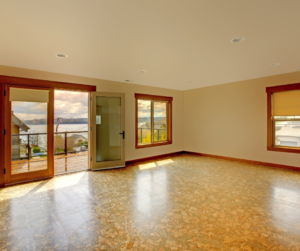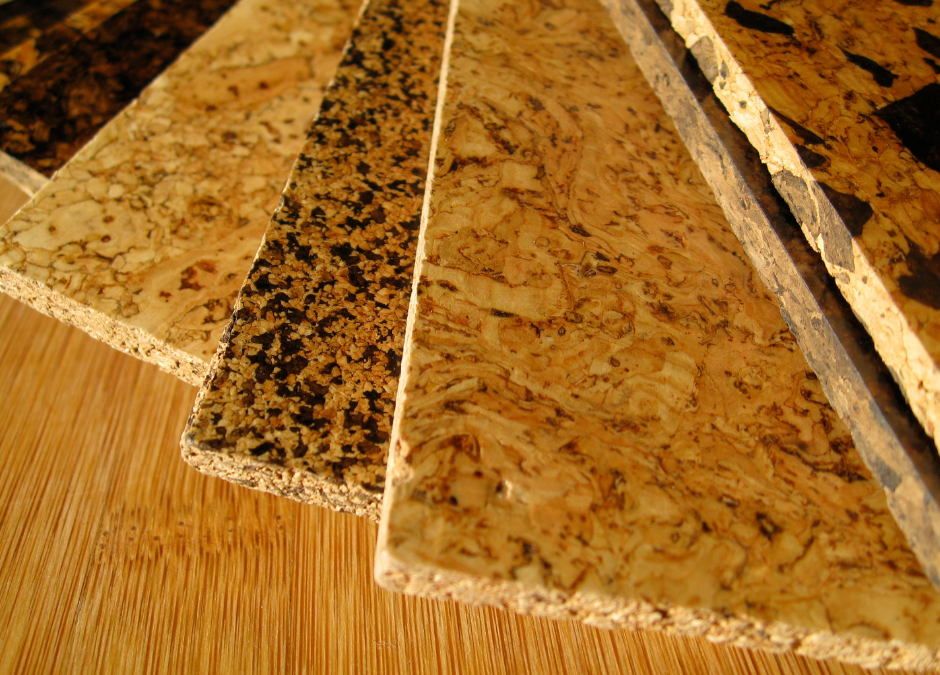By Jan Soults Walker
March 18, 2016
On the hunt for a flooring material that’s attractive, easy underfoot, and not harmful to the environment? Cork flooring could be the perfect choice for you. Here’s what you need to know before you decide.
There’s so much to like about cork flooring. Ask someone in the know about cork flooring and the first word you’re likely to hear is “comfortable.” This natural material is exceptionally resilient, putting a spring in your step as you walk. Drop your favorite serving dish on it, and it just might survive. And, the same properties that make it soft underfoot also make it a good insulator, so it absorbs sound and also feels warm on your toes when it’s cold out and comfortably cool when temperatures soar. Cork flooring is even antistatic, so you won’t produce a spark when you walk across the surface and touch someone or another object. Maybe the best bonus of all? The color variations of cork floors hide dirt.
Cork comes from bark harvested from cork oak trees, which can live for more than a couple centuries, and the bark grows back after harvesting — a closely regulated process. Most cork flooring is made from the by-products of another manufacturing process: Leftover bits and pieces of cork are gathered up from the postproduction of bottle stoppers, ground into fine grains, pressed, and heated to create sheets of cork flooring. That’s an earth-friendly material!
If someone in your household is allergy-prone, cook flooring is a good option because it doesn’t attract dirt. Even better, it contains a naturally occurring element that resists mold and insects.
Cork Flooring Materials and Costs
Sheets of cork flooring can be professionally installed in your home for a seamless look. If you prefer to install cork yourself, choose tiles or planks that feature a cork veneer on rigid backing. While most tiles offer adhesive backing, planks are typically tongue-and-groove so they snap or glue together as a “floating” installation similar to laminate flooring.
Cork flooring is prized for its earthy richness and varying shades and textures, but you can change things up by choosing a version with vibrant color or appealing patterns. Some mimic the look of other materials, such as stone, tile, or wood.
Cork is a great option wherever you want warmth and comfort, such as in a family room, office, or bedroom — especially rooms where children crawl or play on the floor. You can install cork in the kitchen too, but plan to place rugs or mats in front of the kitchen sink and stove to catch spills and reduce wear on protective coatings. When spills happen, simply wipe them up. Some experts caution against allowing water to stand on cork, but manufacturers point out that fisherman have used cork net floats for centuries. With that in mind, you can install cork in wet areas, such as the bathroom or laundry, but consult a flooring dealer or professional installer about the best methods, such as caulking the floor perimeter to prevent water from seeping below tiles and loosening adhesive. You might also decide to apply additional coats of clear polyurethane.
Plan to pay anywhere from $1 to $8 per square foot for cork flooring, plus an additional $1 to $6 per square foot for installation. Choose the thickest product you can afford; less-expensive cork floors tend to be thin and less durable.
Cork Flooring Care
Gritty particles can scratch the surface of cork flooring, so plan to sweep or vacuum regularly — at least a few times a week. Install breathable walk-off mats (no rubber backing) at entryways to catch debris. Also, damp-mop now and then.
The weight of furnishings can indent or damage cork flooring and dragging a piece across cork flooring can scratch or even gouge the surface. So always use coasters under especially heavy pieces and felt pads on the tips of chair legs. Be aware too that the color of cork flooring fades in direct sunlight. If that’s a concern, draw window treatments closed during times of day when the sun’s most intense.
Whether your choice of cork flooring comes presealed or not, plan to reseal the surface periodically (when the surface becomes dull or worn) with clear polyurethane to protect the material from damage. A wax finish is another option, but you’ll have to strip the wax and apply a fresh coat more frequently than you would with clear polyurethane.
Matney Construction, located in Mount Airy, Maryland, specializes in building new homes and residential remodeling. We know that the decision to build or remodel a home is no easy thing. As a family owned and operated business, we work closely with our clients to create their dream home, from custom floor plans and options, to bath and kitchen remodels. Whether it’s a single room or an entire home, we pride ourselves on meeting your quality standards, timeline and budget. Contact us today to have our professional design experts help you make your home unique, stylish, and in-tune with your personality. (410) 635-2500 info@matneyservices.com
Source: By Jan Soults Walker – https://www.bhg.com/home-improvement/flooring/types/cork-flooring-281474979490271/

